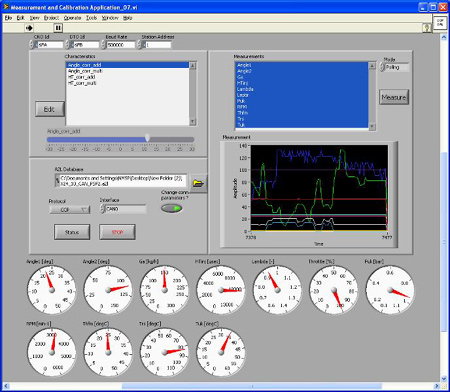Instrumentation
Test systems are only as good as the instrumentation used to measure and record data; without the ability to undertake accurate measurements, reliable testing cannot be conducted. However, as test beds increase in complexity, so does the volume of data generated by their sensors, making rapid interpretation of results difficult without efficient data management and analysis systems.
Generally speaking, most dynamometer manufacturers will supply sensors and a data management interface with their test systems, often featuring their own proprietary data analysis software. The benefit of such a system is that set-up and integration of the components is simple. Often the data acquisition system and dyno controls will be integrated into a single console, with a Windows-based PC to deal with software operation.
However, depending on the manufacturer, the capability and versatility of these systems can be somewhat limited. The most basic instrumentation systems necessary to record general engine operating parameters will include the following sensors:
" Brake torque
" Engine speed
" Engine power
" Exhaust gas temperature
" Intake air pressure and temperature
" Coolant temperature
" Oil pressure and temperature
" Fuel and air mass flow
" Air-to-fuel ratio
Although most of these sensors are already fitted to many engines, for testing purposes their roles will be duplicated by those linked to the dyno's data system. This allows factors such as the ECU's signal conditioning performance to be analysed, without the risk of the results being compromised by any potential interference from the data acquisition system.
When testing becomes more involved, for example once parameters such as cylinder pressures need to be measured, the number of data inputs required increases considerably. A fully instrumented test bed can have anything up to 150 sensors, all recording in real time and, depending on their role, sometimes needing to be logged at a very high rate. There will also be a mixture of digital and analogue signals that need to be handled, with each analogue channel requiring a signal conditioner to process its output before it is received by the data analysis system.
Again, most dynamometer manufacturers can supply expansion boards for their systems, which can often be daisy-chained together to increase capacity further. At the same time, the data analysis programs are also scalable, allowing users to create new channels and determine the values of the data shown. A typical expansion board will feature a mix of different input and outputs, such as dedicated pressure, load cell and frequency inputs as well as outputs for controlling components such as throttle servos.
Once you have all of the required inputs and outputs, the challenge then becomes one of organising the mountains of data that can be gathered. It is here that the usability of a given software analysis package comes into its own. The most highly developed systems allow for many different channels to be arranged logically, and information from different test sessions easily overlaid for comparison. Generally, there are also facilities for creating custom maths channels to calculate specific parameters, which may be unique to a particular test.
Overall, whatever you may want to investigate - be it the simple optimisation of an ECU or a comprehensive engine endurance test - there are sensors and data systems out there that allow you to do so.

Fig. 1 - A typical display screen from a dynamometer control and logging console, showing key engine operating parameters and channels of logged data
Written by Lawrence Butcher